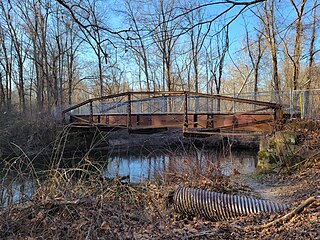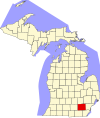
Washtenaw County is a county located in the U.S. state of Michigan. At the 2020 census, the population was 372,258. The county seat and largest city is Ann Arbor. The county was authorized by legislation in 1822 and organized as a county in 1826. Washtenaw County comprises the Ann Arbor Metropolitan Statistical Area. The county is home to the University of Michigan, Eastern Michigan University, Washtenaw Community College, and Concordia University Ann Arbor.

Scio Township is a civil township of Washtenaw County in the U.S. state of Michigan. The population was 17,552 at the 2020 census.

The Wills Creek Bollman Bridge originally served the Baltimore and Ohio Railroad's Pittsburgh Division main line.

The Hares Hill Road Bridge is a single-span, wrought iron, bowstring-shaped lattice girder bridge. It was built in 1869 by Moseley Iron Bridge and Roof Company and is the only known surviving example of this kind. The bridge spans French Creek, a Pennsylvania Scenic River.

Blackfriars Bridge in London, Ontario, Canada is a wrought iron bowstring arch through truss bridge, crossing the North Thames River. The bridge was constructed in 1875 and carries single-lane vehicles, bicycles and pedestrians from Blackfriars Street to Ridout Street North.
The Wrought Iron Bridge Company was a bridge fabrication and construction company based in Canton, Ohio, United States. It specialized in the fabrication of iron truss bridges and was a prolific bridge builder in the late 19th century. It was one of the 28 firms consolidated by J. P. Morgan into the American Bridge Company in 1900. Many of its bridges have been listed on the National Register of Historic Places.

Caneadea Bridge, also known as East Hill Road Bridge, is a historic steel truss bridge that carries County Road 46 over the Genesee River in Caneadea, Allegany County, New York. It is listed on the National Register of Historic Places.

The Border-to-Border (B2B) Trail is a partially constructed non-motorized trail system in Washtenaw County, Michigan. The system is planned to cover approximately 55 miles (89 km) across Washtenaw County, along the Huron River.

The Second Street Bridge is a one-lane, single-span truss bridge in Allegan, in the U.S. state of Michigan, that carries Second Street over the Kalamazoo River. It is a Michigan State Historic Site, a National Historic Civil Engineering Landmark, and is listed on the National Register of Historic Places. Built in 1886, the bridge replaced an earlier wooden structure. In the early 1980s, the bridge underwent significant renovation.

The Bell Road Bridge is a Pratt through truss bridge in Dexter Township, Washtenaw County, Michigan. Built in 1891, the bridge carried Bell Road over the Huron River. From 1997 to 2018, the bridge sat on the riverbank, overgrown with brush. The bridge is a Michigan State Historic Site and is listed on the National Register of Historic Places.

The Butts Bridge carries Butts Bridge Road over the Quinebaug River in the town of Canterbury, Connecticut. It is a well-preserved example of a Parker truss, built in 1937, late in the state's regular use of steel truss bridge designs. The bridge is also known as Bridge No. 1649 and carries an average of 2,300 vehicles per day as of 2011. It was listed on the National Register of Historic Places in 2010.

The Sixth Street Bridge is a four-span, wrought iron bridge that crosses the Grand River in Grand Rapids, Michigan. It is a Michigan State Historic Site and is listed on the National Register of Historic Places. Built in 1886, it is the longest and oldest metal truss bridge in Michigan.

The Goodyear Block, also known as the Arbeiter Block is a commercial building located at 138 E. Main Street in Manchester, Michigan, US. It was listed on the National Register of Historic Places in 1993.
McMillans Bridge, is a riveted wrought iron open web truss bridge, located over the Woady Yaloak River on the Rokewood-Skipton Road between Rokewood and Werneth on a historical route between Geelong and the 1850s goldfields at Ararat and Streatham.

The Iron Bridge at Howard Hill Road is a modern pony truss bridge, carrying Howard Hill Road across the Black River in southeastern Cavendish, Vermont. It is the replacement for a historic 1890 Pratt through truss bridge, which is now in storage. The historic bridge was listed on the National Register of Historic Places in 1982.

The Foundry Bridge is a historic Warren pony truss bridge, carrying Foundry Road across the First Branch White River in Tunbridge, Vermont. Built in 1889, it is one of the state's oldest wrought iron bridges, and the only surviving example in the state of work by the Vermont Construction Company, its only local manufacturer of such bridges. It was listed on the National Register of Historic Places in 2007.

The Old Boardman Bridge, formerly Boardman Bridge, is a historic lenticular truss bridge, which used to carry Boardman Road across the Housatonic River in New Milford, Connecticut. Built from 1887 to 1888 out of wrought iron, it is one of the state's three surviving examples of this bridge type, and along with Lover's Leap Bridge, one of two in New Milford. It was listed on the National Register of Historic Places in 1976. The bridge was closed to vehicles in 1984 and to pedestrians in 1985; however, the Town of New Milford is seeking to restore it and reopen it to pedestrian traffic.

The Stancer Road–North Coldwater River Bridge is a road bridge carrying Stancer Road over the North Coldwater River in Union Township, Michigan. It was listed on the National Register of Historic Places in 1999. It is an excellent example of a pinned overhead Pratt truss bridge, which was once common in Michigan but is now quite rare.

The Melrose Road Bridge is a historic bridge at the western end of Melrose Road in East Windsor, Connecticut. Built in 1888, it is one of a small number of surviving 19th-century lenticular pony truss bridges in the state. It was listed on the National Register of Historic Places in 1999. It was closed for many years, and lacked stringers and decking. In 2017, the town received an $85,000 state grant to add a new pedestrian deck between the historic trusses and to construct connecting trails.

The Parshallburg Bridge, also known as the Ditch Road Bridge, was a bridge that originally carried Ditch Road over the Shiawassee River near Oakley, Michigan. It was listed on the National Register of Historic Places in 1994. It was the only known Thacher through truss bridge in Michigan, and one of only a few remaining in the nation. In 1999, the bridge was moved to a new location, and in 2008 was washed off its piers and destroyed.
























